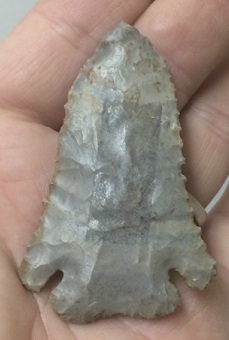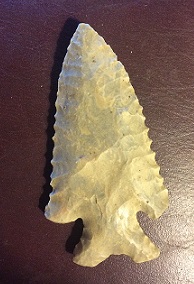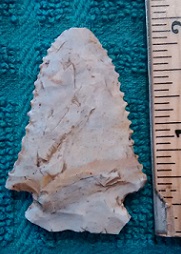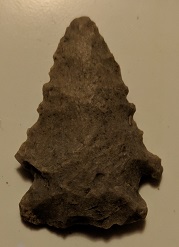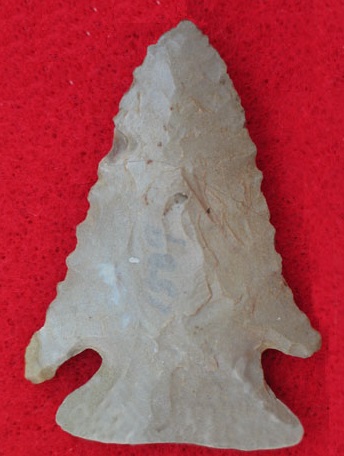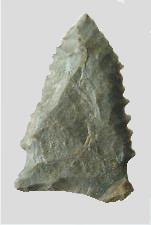Outline is Representative of Size and Shape:

Name Details:
Identified By: Bettye J. Broyles
Named For: Bettye J. Broyles
Date Identified: 1971
Type Site: St. Albans Site, Kanawha County, West Virginia
Identified By: Bettye J. Broyles
Named For: Bettye J. Broyles
Date Identified: 1971
Type Site: St. Albans Site, Kanawha County, West Virginia
Point Validity:
Valid type
Broyles is a distinguished Anthropologist who was a professor at many prestigious universities. She is most known for her excavations at St. Albans Site in West Virginia. This type was named in a professional publication and has many professional references. This is a valid type.
Broyles is a distinguished Anthropologist who was a professor at many prestigious universities. She is most known for her excavations at St. Albans Site in West Virginia. This type was named in a professional publication and has many professional references. This is a valid type.
Charleston Corner Notched
AKA: Charleston Pine TreeCluster: Kirk Corner Notch Cluster
Description of Physical Characteristics and Flaking Pattern:
This is a medium to large triangular corner notched point with a median ridge cross section. The blade is primarily outward recurvate and mostly commonly asymmetrical which is a key identification feature. The shoulders are strongly barbed. Heavily re-sharpened points may have slightly barbed shoulders and may have an almost straight blade. The stem is expanding. The base may vary from convex to concave and have basal thinning. This point is most noted for parallel oblique flaking, but some examples may have a random pattern (Justice, 2002).
Size Measurements:
Total Length - 40 to 85 mm (45 to 55 mm average), Stem Length- 9 to 13 mm, Blade Width - 23 to 38 mm (25 to 35 mm average), Neck Width - 14 to 18 mm, Stem Width - 17 to 30 mm, Thickness - 7 to 8 mm
Total Length - 40 to 85 mm (45 to 55 mm average), Stem Length- 9 to 13 mm, Blade Width - 23 to 38 mm (25 to 35 mm average), Neck Width - 14 to 18 mm, Stem Width - 17 to 30 mm, Thickness - 7 to 8 mm
Commonly Utilized Material:
Additional Comments:
There is a lot of confusion regarding this point and the Pine Tree Corner Notched. Much of this confusion may come from the similar appearance of these points and the overlapping distribution. Also, other identification guides have listed the two points as the same point with a northern and southern distribution which is incorrect. Another factor is many people refer to this point as a Charleston Pine Tree which takes both types and combines them in one. The two points are not the same, the Charleston Corner Notched was found in levels below the Kirk Corner Notched point at St. Albans site and Ice House Bottom site (Justice, 2002). This point pre-dates the Kirk Corner Notched point. The Pine Tree point is a Kirk variant with the same dates as the Kirk point. There are a few things that must be kept in mind regarding the two points. First is the distribution. Both point have a southern distribution, but the Charleston point is also found further east and the Pine Tree point is found further north. Second, Broyle (1971), notes that the Charleston blade is generally shorter and wider. The blade is most commonly recurvate and asymmetrical for the Charleston point (Justice, 2002). Also, the Charleston point more commonly has a median ridge which is less common with the Pine Tree. Third, the Pine Tree is a variant of a re-sharpened Kirk so the base is consistent with a Kirk Base. Like the Palmer point which also predates the Kirk, basal grinding is more common for the Charleston and less common for the Pine Tree.
There is a lot of confusion regarding this point and the Pine Tree Corner Notched. Much of this confusion may come from the similar appearance of these points and the overlapping distribution. Also, other identification guides have listed the two points as the same point with a northern and southern distribution which is incorrect. Another factor is many people refer to this point as a Charleston Pine Tree which takes both types and combines them in one. The two points are not the same, the Charleston Corner Notched was found in levels below the Kirk Corner Notched point at St. Albans site and Ice House Bottom site (Justice, 2002). This point pre-dates the Kirk Corner Notched point. The Pine Tree point is a Kirk variant with the same dates as the Kirk point. There are a few things that must be kept in mind regarding the two points. First is the distribution. Both point have a southern distribution, but the Charleston point is also found further east and the Pine Tree point is found further north. Second, Broyle (1971), notes that the Charleston blade is generally shorter and wider. The blade is most commonly recurvate and asymmetrical for the Charleston point (Justice, 2002). Also, the Charleston point more commonly has a median ridge which is less common with the Pine Tree. Third, the Pine Tree is a variant of a re-sharpened Kirk so the base is consistent with a Kirk Base. Like the Palmer point which also predates the Kirk, basal grinding is more common for the Charleston and less common for the Pine Tree.
Distribution: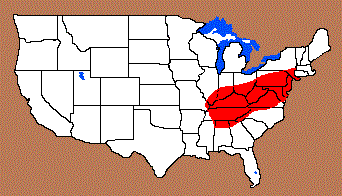
Distribution Comments:
This point is found from the mid Mississippi River Basin through the Ohio River valley to the Atlantic coast. This point is also found in the Tennessee River Basin.
This point is found from the mid Mississippi River Basin through the Ohio River valley to the Atlantic coast. This point is also found in the Tennessee River Basin.
Age / Periods:
Date: 9,500 - 8,000 B.P.
Cultural Period: Early Archaic
Glacial Period: Early Holocene
Culture:
Date: 9,500 - 8,000 B.P.
Cultural Period: Early Archaic
Glacial Period: Early Holocene
Culture:
Age Details:
This type is part of the Early Archaic Phase I.
This type is part of the Early Archaic Phase I.
Other points in this cluster / Related / Associated Points:
Amos, Decatur, Kirk Corner Notch, Palmer, Pine Tree Corner Notch, Stilwell
Amos, Decatur, Kirk Corner Notch, Palmer, Pine Tree Corner Notch, Stilwell

